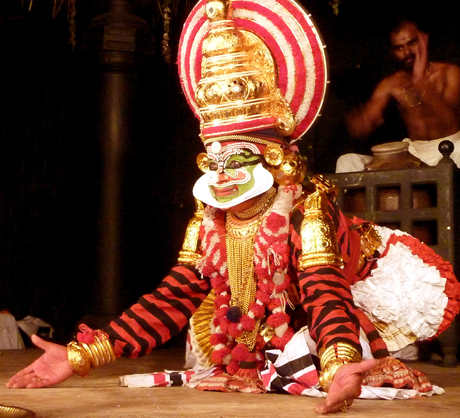Gods and Demons
Organized by Elisa Ganser (URPP Asia and Europe) in collaboration with Elena Mucciarelli (University of Tübingen), the University of Zurich’s Ethnographic Museum presented two performances of Kutiyattam by the ensemble Nepathya on July 26, 2016. Kutiyattam, literally “playing together,” is a regional form of Sanskrit theater stemming from Kerala, South India.
Elisa Ganser
With roots reaching back into the medieval period, Kutiyattam was declared immaterial world heritage by UNESCO in 2001. The ensemble Nepathya, based in the village of Moozhikulam in Kerala, acts both as a company and as a school for training actors and musicians. It was founded by Margi Madhu Chakyar, the company’s director and one of today’s major exponents of Kutiyattam theater. A complete representation of a single act from one of the classical Sanskrit plays can take up to one month. The dramatic texts are transmitted within the families of actors, replete with elaborate acting protocols and stage directions. Nepathya not only trains young artists in the sophisticated techniques of Kutiyattam playing together, but also contributes to transmitting and preserving a classical repertoire. That is, were it not for Kutiyattam artists’ bringing the plays to life on stage, they would end up in manuscript libraries as dead letter.

Performances of Kutiyattam are traditionally held in Kerala temples in front of an assembly of humans and gods. Due to time constraints and the different setting, the Ethnographic Museum has been home to the staging of two extracts adapted from larger plays, and separated by a one-hour session of questions and answers between the public and the artists. This dialogue revolved especially around the first piece, enacted by Dr. Indu G and called Putanamoksham (“The Liberation of the Demoness Putana”). The dialogue also served as preparation for the second piece Toranayuddham (“The Battle at the Portals”), performed by Margi Madhu Chakyar and the musicians of Nepathya: Kalamandalam Manikandam and Nepathya Jinesh on the Mizhavu drums, Kalanilayan Rajan on the Edakkya drum.
Emotions between love and anger
The first piece, Putanamoksham, narrates how the dreadful demoness Putana, with copper-like hair, bulging eyes and big canine teeth, failed to poison the godly baby Krishna, and was killed in his stead, thus reaching spiritual liberation at the hands of the god. As Putana reaches Krishna’s house and holds him in her hands, she experiences a moment of deep conflict and undergoes contrasting emotions, all enacted by Indu G through subtly changing expressions to correspond with different moods: motherly love towards the prodigious child, grief for the thought of killing him, anger towards his uncle Kamsa who ordered the killing.
The second piece stems from the third act of Bhasa’s classical Sanskrit play Abhishekanatakam. On the verge of death, a demon (Ravana) remembers his deeds at the doors of the citadel: how he lifted mount Kailasa and played with it; how at that time, on that very mountain, Shiva and Parvati were in a dispute over the god’s holding another woman, Ganga, in his hair; how the two of them were reconciled as Parvati fell into Shiva’s arms, letting loose of her jealousy, fearful of the earthquake caused by the uplifted Kailasa. The multiplication of points of view, typical of this theater, was played out by Margi Madhu Chakyar through a skillful exchange of roles, alternating feminine and masculine characters.
Kutiyattam theater leaves plenty of space to the play of visual expressions, accentuated through a sophisticated make-up-made mask (Ravana’s face-paint required more than three hours of work by the artist Kalamandalam Ravikumar). It also involves a visual vocabulary of codified hand-gestures, as demonstrated by Rebecca Weckenmann in the introduction to both plays. As an assistant, Madhu and Indu’s son Sreehari also contributed to the success of the performance, coordinating the subtitles with the gestures of this pantomimic theater, another effort at translating this art for the appreciative audience gathered in the Museum’s auditorium.
Rules and improvisation
As Indu G explained, despite the repertoire’s fixity and the numerous rules and conventions of Kutiyattam techniques, Kutiyattam is nonetheless an art of improvisation that requires constant dialogue during the play between actors and musicians. In the conventional setting of the Kutiyattam stage, with the orchestra at the back and the actors in the front, a good musician will accompany the actor’s movements, but an excellent one will also tune with the actor’s imagination. Made lively by the engaging presence of the artists of Nepathya, this event was conceived as a space for dialogue, which is one of the aims of the Ethnographic Museum: rather than being just a space for the exhibition of cultural diversity, the Museum is a space for encounter and cultural translation, as its director Mareile Flitsch pointed out in her welcoming address at the outset of the event.
(Asia & Europe Bulletin, 5/2016, pp. 32–33)